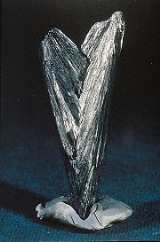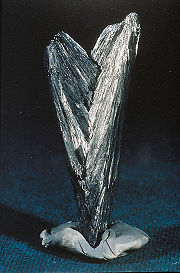
Manganite
Encyclopedia
Manganite is a mineral
. Its composition is manganese
oxide
-hydroxide
, MnO(OH), crystallizing in the monoclinic system (pseudo-orthorhombic). Crystals of manganite are prismatic and deeply striated parallel to their length; they are often grouped together in bundles. The color is dark steel-grey to iron-black, and the luster
brilliant and submetallic. The streak is dark reddish-brown. The hardness is 4, and the specific gravity
is 4.3. There is a perfect cleavage parallel to the brachypinacoid, and less-perfect cleavage parallel to the prism faces. Twinned crystals
are not infrequent.
The mineral contains 89.7% manganese sesquioxide; it dissolves in hydrochloric acid
with evolution of chlorine
.
 Manganite occurs with other manganese oxides in deposits formed by circulating meteoric water
Manganite occurs with other manganese oxides in deposits formed by circulating meteoric water
in the weathering environment in clay deposits and laterite
s. It forms by low temperature hydrothermal action in veins
in association with calcite, barite, and siderite
. Often associated with pyrolusite
, braunite
, hausmannite
and goethite
.
Manganite occurs in specimens exhibiting good crystal form at Ilfeld in the Harz Mountains of Germany
, where the mineral occurs with calcite
and barite
in veins traversing porphyry
. Crystals have also been found at Ilmenau in Thuringia, Neukirch near Sélestat
in Alsace
(newkirkite), Granam near Towie
in Aberdeenshire, and in Upton Pyne
near Exeter
, UK and Negaunee, Michigan
, United States
, and in the Pilbarra of Western Australia
. Good crystals have also been found at Atikokan, Ontario and Nova Scotia, Canada. As an ore
of manganese it is much less abundant than pyrolusite
or psilomelane
.
Although described with various other names as early as 1772, the name manganite was first applied in a publication by W. Haidinger in 1827.

Mineral
A mineral is a naturally occurring solid chemical substance formed through biogeochemical processes, having characteristic chemical composition, highly ordered atomic structure, and specific physical properties. By comparison, a rock is an aggregate of minerals and/or mineraloids and does not...
. Its composition is manganese
Manganese
Manganese is a chemical element, designated by the symbol Mn. It has the atomic number 25. It is found as a free element in nature , and in many minerals...
oxide
Oxide
An oxide is a chemical compound that contains at least one oxygen atom in its chemical formula. Metal oxides typically contain an anion of oxygen in the oxidation state of −2....
-hydroxide
Hydroxide
Hydroxide is a diatomic anion with chemical formula OH−. It consists of an oxygen and a hydrogen atom held together by a covalent bond, and carrying a negative electric charge. It is an important but usually minor constituent of water. It functions as a base, as a ligand, a nucleophile, and a...
, MnO(OH), crystallizing in the monoclinic system (pseudo-orthorhombic). Crystals of manganite are prismatic and deeply striated parallel to their length; they are often grouped together in bundles. The color is dark steel-grey to iron-black, and the luster
Lustre (mineralogy)
Lustre is a description of the way light interacts with the surface of a crystal, rock, or mineral. The word lustre traces its origins back to the Latin word lux, meaning "light", and generally implies radiance, gloss, or brilliance....
brilliant and submetallic. The streak is dark reddish-brown. The hardness is 4, and the specific gravity
Specific gravity
Specific gravity is the ratio of the density of a substance to the density of a reference substance. Apparent specific gravity is the ratio of the weight of a volume of the substance to the weight of an equal volume of the reference substance. The reference substance is nearly always water for...
is 4.3. There is a perfect cleavage parallel to the brachypinacoid, and less-perfect cleavage parallel to the prism faces. Twinned crystals
Crystal twinning
Crystal twinning occurs when two separate crystals share some of the same crystal lattice points in a symmetrical manner. The result is an intergrowth of two separate crystals in a variety of specific configurations. A twin boundary or composition surface separates the two crystals....
are not infrequent.
The mineral contains 89.7% manganese sesquioxide; it dissolves in hydrochloric acid
Hydrochloric acid
Hydrochloric acid is a solution of hydrogen chloride in water, that is a highly corrosive, strong mineral acid with many industrial uses. It is found naturally in gastric acid....
with evolution of chlorine
Chlorine
Chlorine is the chemical element with atomic number 17 and symbol Cl. It is the second lightest halogen, found in the periodic table in group 17. The element forms diatomic molecules under standard conditions, called dichlorine...
.
Occurrence

Meteoric water
Meteoric water is a hydrologic term of long standing for water in the ground which originates from precipitation. This includes water from lakes, rivers, and icemelts, which all originate from precipitation indirectly.- Overview :...
in the weathering environment in clay deposits and laterite
Laterite
Laterites are soil types rich in iron and aluminium, formed in hot and wet tropical areas. Nearly all laterites are rusty-red because of iron oxides. They develop by intensive and long-lasting weathering of the underlying parent rock...
s. It forms by low temperature hydrothermal action in veins
Vein (geology)
In geology, a vein is a distinct sheetlike body of crystallized minerals within a rock. Veins form when mineral constituents carried by an aqueous solution within the rock mass are deposited through precipitation...
in association with calcite, barite, and siderite
Siderite
Siderite is a mineral composed of iron carbonate FeCO3. It takes its name from the Greek word σίδηρος sideros, “iron”. It is a valuable iron mineral, since it is 48% iron and contains no sulfur or phosphorus...
. Often associated with pyrolusite
Pyrolusite
Pyrolusite is a mineral consisting essentially of manganese dioxide and is important as an ore of manganese. It is a black, amorphous appearing mineral, often with a granular, fibrous or columnar structure, sometimes forming reniform crusts. It has a metallic luster, a black or bluish-black...
, braunite
Braunite
Braunite is a silicate mineral containing both di- and tri-valent manganese with the chemical formula:Mn2+Mn3+6[O8|SiO4]. Common impurities include iron, calcium, boron, barium, titanium, aluminium, and magnesium....
, hausmannite
Hausmannite
Hausmannite is a complex oxide of manganese containing both di- and tri-valent manganese. The formula can be represented as Mn2+Mn3+2O4. It belongs to the spinel group and forms tetragonal crystals...
and goethite
Goethite
Goethite , named after the German polymath Johann Wolfgang von Goethe, is an iron bearing oxide mineral found in soil and other low-temperature environments. Goethite has been well known since prehistoric times for its use as a pigment. Evidence has been found of its use in paint pigment samples...
.
Manganite occurs in specimens exhibiting good crystal form at Ilfeld in the Harz Mountains of Germany
Germany
Germany , officially the Federal Republic of Germany , is a federal parliamentary republic in Europe. The country consists of 16 states while the capital and largest city is Berlin. Germany covers an area of 357,021 km2 and has a largely temperate seasonal climate...
, where the mineral occurs with calcite
Calcite
Calcite is a carbonate mineral and the most stable polymorph of calcium carbonate . The other polymorphs are the minerals aragonite and vaterite. Aragonite will change to calcite at 380-470°C, and vaterite is even less stable.-Properties:...
and barite
Barite
Baryte, or barite, is a mineral consisting of barium sulfate. The baryte group consists of baryte, celestine, anglesite and anhydrite. Baryte itself is generally white or colorless, and is the main source of barium...
in veins traversing porphyry
Porphyry (geology)
Porphyry is a variety of igneous rock consisting of large-grained crystals, such as feldspar or quartz, dispersed in a fine-grained feldspathic matrix or groundmass. The larger crystals are called phenocrysts...
. Crystals have also been found at Ilmenau in Thuringia, Neukirch near Sélestat
Sélestat
Sélestat is a commune in the Bas-Rhin department in Alsace in north-eastern France.In 2006, Sélestat had a total population of 19,459. The Communauté de communes de Sélestat et environs had a total population of 35,397.-Geography:...
in Alsace
Alsace
Alsace is the fifth-smallest of the 27 regions of France in land area , and the smallest in metropolitan France. It is also the seventh-most densely populated region in France and third most densely populated region in metropolitan France, with ca. 220 inhabitants per km²...
(newkirkite), Granam near Towie
Towie
Towie is a small hamlet in Aberdeenshire, Scotland, close to Alford and Lumsden.One of the most notable features of Towie is its small primary school with nursery, which is located in the village itself. Towie also has a bowling club and a beautiful church with historic graveyard.The village is...
in Aberdeenshire, and in Upton Pyne
Upton Pyne
Upton Pyne is a parish and village in Devon, England. The parish lies just north west of Exeter, mainly between the River Exe and River Creedy. The village is located north of Cowley and west of Brampford Speke and Stoke Canon.-History:...
near Exeter
Exeter
Exeter is a historic city in Devon, England. It lies within the ceremonial county of Devon, of which it is the county town as well as the home of Devon County Council. Currently the administrative area has the status of a non-metropolitan district, and is therefore under the administration of the...
, UK and Negaunee, Michigan
Negaunee, Michigan
Negaunee is a city in Marquette County in the U.S. state of Michigan. The population was 4,576 at the 2000 census. The city is located at the southwest corner of Negaunee Township. The city is home to the Michigan Iron Industry Museum...
, United States
United States
The United States of America is a federal constitutional republic comprising fifty states and a federal district...
, and in the Pilbarra of Western Australia
Western Australia
Western Australia is a state of Australia, occupying the entire western third of the Australian continent. It is bounded by the Indian Ocean to the north and west, the Great Australian Bight and Indian Ocean to the south, the Northern Territory to the north-east and South Australia to the south-east...
. Good crystals have also been found at Atikokan, Ontario and Nova Scotia, Canada. As an ore
Ore
An ore is a type of rock that contains minerals with important elements including metals. The ores are extracted through mining; these are then refined to extract the valuable element....
of manganese it is much less abundant than pyrolusite
Pyrolusite
Pyrolusite is a mineral consisting essentially of manganese dioxide and is important as an ore of manganese. It is a black, amorphous appearing mineral, often with a granular, fibrous or columnar structure, sometimes forming reniform crusts. It has a metallic luster, a black or bluish-black...
or psilomelane
Psilomelane
Psilomelane, also known as black hematite, is a group name for hard black manganese oxides such as hollandite and romanechite. Psilomelane consists of hydrous manganese oxide with variable amounts of barium and potassium.-Formula:...
.
Although described with various other names as early as 1772, the name manganite was first applied in a publication by W. Haidinger in 1827.


